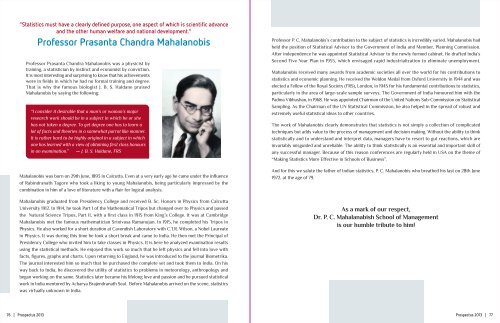Download SKFGI Prospectus - Supreme Knowledge Foundation ...
Download SKFGI Prospectus - Supreme Knowledge Foundation ...
Download SKFGI Prospectus - Supreme Knowledge Foundation ...
You also want an ePaper? Increase the reach of your titles
YUMPU automatically turns print PDFs into web optimized ePapers that Google loves.
“Statistics must have a clearly defined purpose, one aspect of which is scientific advance<br />
and the other human welfare and national development.”<br />
Professor Prasanta Chandra Mahalanobis<br />
Professor Prasanta Chandra Mahalanobis was a physicist by<br />
training, a statistician by instinct and economist by conviction.<br />
It is most interesting and surprising to know that his achievements<br />
were in fields in which he had no formal training and degree.<br />
That is why the famous biologist J. B. S. Haldane praised<br />
Mahalanobis by saying the following:<br />
“I consider it desirable that a man’s or woman’s major<br />
research work should be in a subject in which he or she<br />
has not taken a degree. To get degree one has to learn a<br />
lot of facts and theories in a somewhat parrot like manner.<br />
It is rather hard to be highly original in a subject in which<br />
one has learned with a view of obtaining first class honours<br />
in an examination.” ---- J. B. S. Haldane, FRS<br />
Mahalanobis was born on 29th June, 1893 in Calcutta. Even at a very early age he came under the influence<br />
of Rabindranath Tagore who took a liking to young Mahalanobis, being particularly impressed by the<br />
combination in him of a love of literature with a flair for logical analysis.<br />
Mahalanobis graduated from Presidency College and received B. Sc. Honors in Physics from Calcutta<br />
University 1912. In 1914, he took Part I of the Mathematical Tripos but changed over to Physics and passed<br />
the Natural Science Tripos, Part II, with a first class in 1915 from King’s College. It was at Cambridge<br />
Mahalanobis met the famous mathematician Srinivasa Ramanujan. In 1915, he completed his Tripos in<br />
Physics. He also worked for a short duration at Cavendish Laboratory with C.T.R. Wilson, a Nobel Laureate<br />
in Physics. It was during this time he took a short break and came to India. He then met the Principal of<br />
Presidency College who invited him to take classes in Physics. It is here he analyzed examination results<br />
using the statistical methods. He enjoyed this work so much that he left physics and fell into love with<br />
facts, figures, graphs and charts. Upon returning to England, he was introduced to the journal Biometrika.<br />
The journal interested him so much that he purchased the complete set and took them to India. On his<br />
way back to India, he discovered the utility of statistics to problems in meteorology, anthropology and<br />
began working on the same. Statistics later became his lifelong love and passion and he pursued statistical<br />
work in India mentored by Acharya Brajendranath Seal. Before Mahalanobis arrived on the scene, statistics<br />
was virtually unknown in India.<br />
Professor P. C. Mahalanobis’s contribution to the subject of statistics is incredibly varied. Mahalanobis had<br />
held the position of Statistical Advisor to the Government of India and Member, Planning Commission.<br />
After independence he was appointed Statistical Advisor to the newly formed cabinet. He drafted India’s<br />
Second Five Year Plan in 1955, which envisaged rapid industrialization to eliminate unemployment.<br />
Mahalanobis received many awards from academic societies all over the world for his contributions to<br />
statistics and economic planning. He received the Weldon Medal from Oxford University in 1944 and was<br />
elected a Fellow of the Royal Society (FRS), London, in 1945 for his fundamental contributions to statistics,<br />
particularly in the area of large-scale sample surveys. The Government of India honoured him with the<br />
Padma Vibhushan, in 1968. He was appointed Chairman of the United Nations Sub-Commission on Statistical<br />
Sampling. As the Chairman of the UN Statistical Commission, he also helped in the spread of robust and<br />
extremely useful statistical ideas to other countries.<br />
The work of Mahalanobis clearly demonstrates that statistics is not simply a collection of complicated<br />
techniques but adds value to the process of management and decision making. Without the ability to think<br />
statistically and to understand and interpret data, managers have to resort to gut reactions, which are<br />
invariably misguided and unreliable. The ability to think statistically is an essential and important skill of<br />
any successful manager. Because of this reason conferences are regularly held in USA on the theme of<br />
“Making Statistics More Effective in Schools of Business”.<br />
And for this we salute the father of Indian statistics, P. C. Mahalanobis who breathed his last on 28th June<br />
1972, at the age of 79.<br />
As a mark of our respect,<br />
Dr. P. C. Mahalanabish School of Management<br />
is our humble tribute to him!<br />
76 | <strong>Prospectus</strong> 2013<br />
<strong>Prospectus</strong> 2013 | 77



